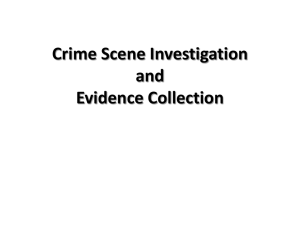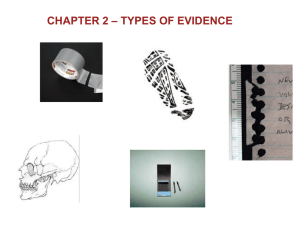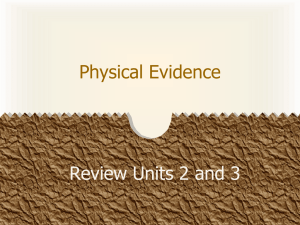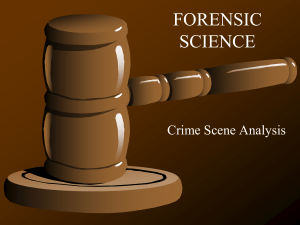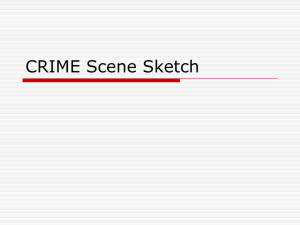PRELIMINARY INVESTIGATION
advertisement
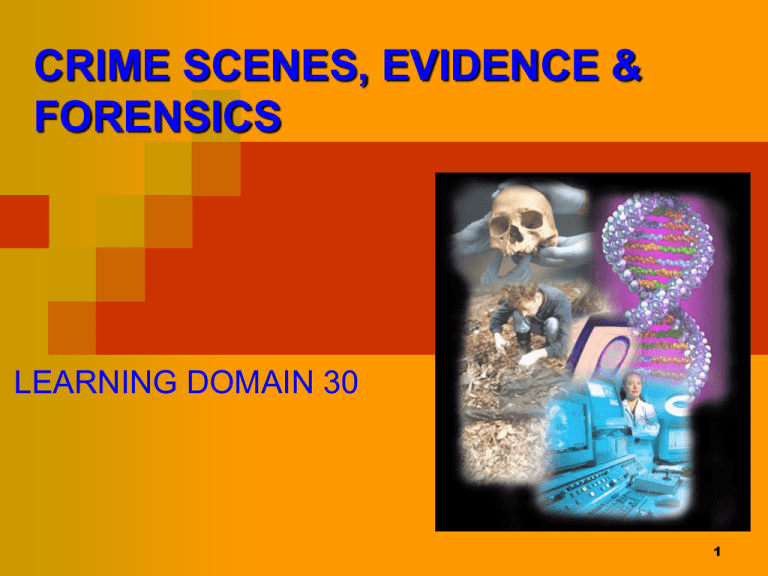
CRIME SCENES, EVIDENCE & FORENSICS LEARNING DOMAIN 30 1 GOAL OF A CRIMINAL INVESTIGATION An investigation is the systematic gathering of information from a variety of sources and the documentation of evidence, observations and findings. A criminal investigation is a systematic approach to the: establishment of a criminal violation identification and arrest of a suspect, and gathering of evidence for presentation in a court of law REMEMBER: the goal of any criminal investigation is the successful prosecution of the guilty and exoneration of the innocent 2 PRELIMINARY INVESTIGATIONS The preliminary investigation begins when the responding officers first arrive at the scene of the incident. It continues through the writing and filing of the primary officer’s investigation report (w/b p. 3-4) “the evidence never lies” Horatio Caine 3 COMPONENTS OF THE PRELIMINARY INVESTIGATION 1) Arrival: (w/b p. 3-5) 2) proceed safely to the scene Assessment: Determine need for emergency medical services Verify that a crime has occurred Identify and arrest suspect(s) if appropriate Provide dispatch with pertinent info ASAP 4 COMPONENTS OF PRELIMINARY INVESTIGATION 3) Preliminary Investigation Secure and protect the crime scene Identify and preserve possible evidence Locate and interview victim(s)/witness(es) Identify other possible sources of info 4) Report Collect available info necessary to write a clear and effective investigative report 5 6 CRIME SCENE PROTECTION CONSIDERATIONS Establish an inner and outer perimeter Assign personnel to maintain perimeters Place fixed barriers to maintain integrity of the scene Maintain a crime scene log If necessary, take additional action to protect the crime scene and physical evidence 7 8 CRIME SCENE SURVEY Initial survey - Identifies the kinds and amounts of evidence that may exist at the crime scene. Purpose gives officers an opportunity to access, time, equipment, personnel needed to process the crime scene. 9 10 CRIME SCENE SEARCH Systematic, coordinated effort conducted in order to: w/b p. 3-14 1. 2. Locate physical evidence that a crime has taken place. Identifies individual (s) who may have committed the crime. Search patterns: choice based on type of crime, size of crime scene, number of personnel available, personal choice. a) b) c) d) e) Line Quadrant Grid Spiral Wheel 11 ADMISSIBILITY OF PHOTOGRAPHS Admissible as evidence if they: (w/b p 3-17) 1. Show an object or person relevant to the crime 2. Accurately represent, without distortion, the object or scene photographed 3. Are marked properly to identify contents and location 4. Are not used solely for the purpose to appeal to the emotions or prejudice the court or jury 12 BASIC SURVEY METHODS Rectangular – Identifies location of an object by it’s distance from two perpendicular lines. Triangulation – objects located by determining where two or more lines intersect (useful out doors). Coordinate/transect – use when the item of evidence lies somewhere along a straight line that has identifiable end points. 13 COLLECTION OF EVIDENCE Prior to collecting, should consider: Photographing evidence to demonstrate appearance when found. Diagramming the location and position of items of evidence to aid in later reconstruction of the scene. Taking notes regarding the physical appearance of evidence to document condition in which it was found. Wearing appropriate clothing for the type of crime scene you are working. 14 HANDLING EVIDENCE At risk evidence – that which can be lost, damaged or contaminated: Fingerprints, biological fluids, stains Gunshot residue, paint chips, hairs & fibers, flammable liquids & accelerants Shoe, foot, tire impressions Trace Evidence – very small not seen with the naked eye Transfer Evidence – easily transferred between two objects, i.e. paint chips, hair, fibers, soil, etc. 15 16 PHOTOGRAPHS Crime Scene Photos: Provide visual record of crime scene Allows court to visualize scene & position of evidence Preserves location of fragile evidence Can be stored indefinitely Show object or person relevant to the crime Accurately represent the object or scene Marked properly to identify contents & location 17 PHOTOGRAPHS General Guidelines: Keep a detailed log Take photos prior to conducting a search Take numerous photos from different angles Use markers & scale measures in photos Use a tripod when available Identify photo taker, time & date, location 18 19 EVIDENCE PACKAGING CONTAINERS Paper – most dry items Cardboard – firearms/knives, dried blood items, that need protection Metal – chemicals, flammable fluids/items Glass – items not compatible with metal, materials with dried biological fluids Plastic – paper, small amounts of processed narcotics 20 CHAIN OF CUSTODY The complete and accurate record of evidence from crime scene to courtroom Property form formats should include the following: (w/b p 3-25) 1) 2) 3) 4) 5) 6) 7) 8) Report number Who initially found the item Where and when item found Item description Who recovered, packaged, and labeled the item Who transported Where submitted Where, how, and when item was secured 21 FORMS OF FINGERPRINTS EVIDENCE Fingerprints: are a copy or impression of ridges and valleys present on the outermost layer of human skin on fingers. Also found on palms, feet and toes. Visible – impressions in blood, paint, grease, etc Plastic – impressions left on soft substance such as heavy grease, melted candle wax, putty, etc Latent – impressions left by secretions from perspirations or oils on the skin (normally invisible to the naked eye until developed) 22 23

